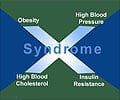New research supports the idea of allowing clinicians to use waist circumference or bioimpedance-based body fat measurements (e.g. smart scales) in addition to BMI.

Body Mass Index: Obesity, BMI, and Health: A Critical Review
Go to source).
Body Mass Index May Not Be the Best Indicator of Health
They identified non-pregnant U.S. adults aged 20-59 years from the 2011-2018 National Health and Nutrition Examination Survey (NHANES) with whole-body DEXA scan data. Their BMI was categorized by ethnicity (non-Asian: underweight<18.5, normal=18.5-24.9, overweight=25-29.9, obese≥30 kg/m2, Asian: <18.5, 18.5-22.9, 23-27.4, 27.5+).‘Including what percentage of the body is fat, muscle, bone, and water, and how much fat is in the abdomen vs. the thighs are important to understand drivers for cardio-metabolic disease. #body mass index #obesity #metabolic health’





The researchers estimated the odds of obesity among adults as normal/overweight based on BMI or total body fat percentage (BF%) as ≥25% in males and ≥32% in females, by race (non-Hispanic White [NHW], non-Hispanic Black [NHB], Asian, Hispanic, and other). They also estimated mean DEXA adiposity measures by race.They found that nearly 36% had a BMI≥30 (the traditional definition of obesity) but 74% had obesity per BF%. Among normal BMI adults, 44% of non-Hispanic Whites, 27% of NHB, 49% of Hispanic, and 49% of Asians had obesity as per BF%. Among normal BMI adults, the mean android-to-gynoid fat ratio was 0.84 for NHW, 0.85 for NHB, 0.89 for Hispanics, and 0.91 for Asians.
Nearly 3 in 4 young-to-middle-aged U.S. adults were considered to have obesity according to BF% from DEXA scans. Asian Americans and Hispanics with seemingly normal BMI were more likely to have obesity, and more likely to have a greater proportion of abdominal fat than non-Hispanic Whites (2✔ ✔Trusted Source
Racial Disparities and Cardiometabolic Risk: New Horizons of Intervention and Prevention
Go to source).
Non-Hispanic Blacks had significantly lower chances of obesity at normal/overweight BMI ranges and a lower proportion of abdominal fat. This research will add to the idea of weight-inclusive care and allow clinicians to routinely use supplementary measures of body fat such as waist circumference or bioimpedance-based body fat measurements in addition to BMI.
Engaging in practices to prevent unconscious biases that may occur when caring for a patient with obese BMI, and engaging in clinical decision-making that is not solely dependent on a BMI calculation but rather an overall idea of body composition and body fat distribution.
Advertisement
- Body Mass Index: Obesity, BMI, and Health: A Critical Review - (https://journals.lww.com/nutritiontodayonline/Fulltext/2015/05000/Body_Mass_Index__Obesity,_BMI,_and_Health__A.5.aspx)
- Racial Disparities and Cardiometabolic Risk: New Horizons of Intervention and Prevention - (https://link.springer.com/article/10.1007/s11892-022-01451-6)
Source-Eurekalert













